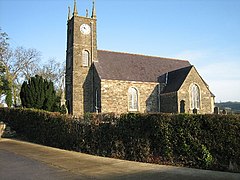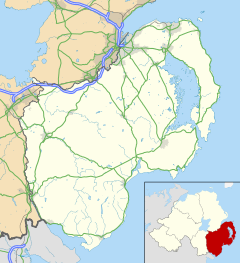Dromara
Dromara
|
|
|---|---|
 St John's Church, Dromara |
|
| Dromara shown within County Down | |
| Population | 597 (2001 Census) |
| Irish grid reference | J287497 |
| • Belfast | 20 mi (32 km) |
| District | |
| County | |
| Country | Northern Ireland |
| Sovereign state | United Kingdom |
| Post town | DROMORE |
| Postcode district | BT25 |
| Dialling code | 028, +44 28 |
| EU Parliament | Northern Ireland |
| UK Parliament | |
| NI Assembly | |
Dromara (from Irish: Droim mBearach, meaning "ridge of ") is a small village, townland (of 242 acres) and civil parish in County Down, Northern Ireland. It lies 10 kilometres (6.2 mi) to the southwest of Ballynahinch on the northern slopes of Slieve Croob, with the River Lagan flowing through it. It is situated in Dromara (civil parish) and the historic barony of Iveagh Lower, Lower Half. In the 2001 Census it had a population of 597 people.
There have been references to a church at Dromara since about 1306. Earlier anglicised names for the church and townland include Drummeragh, Drumaragh and Drumara—these are likely derived from Druim mBearach (modern Irish Droim mBearach) meaning "ridge of heifers". Saint John’s Church now occupies the site of the original church. Dromara eventually became a small mill village and although many of its buildings date from the early 19th century, the street pattern suggests that the settlement has a much earlier history. It used to have its own court and market house and a market place at the road junction in the middle of the village.
Facilities in the village include Dromara Primary School, two churches (St John’s Church of Ireland and Dromara Second Presbyterian Church). Each summer the Dromara Vintage Club hold a vintage rally in the village.
Dromara Village F.C. play association football in the Northern Amateur Football League.
...
Wikipedia

